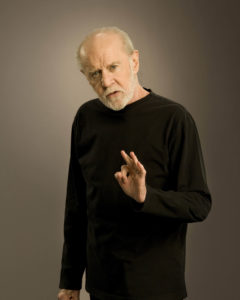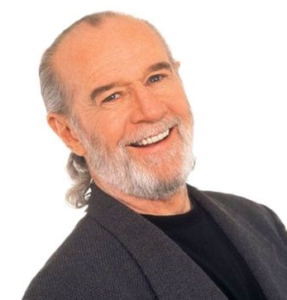Long before I was exposed to Romantic Satanism, the radical tradition spearheaded by English Romanticism’s “Satanic Lord,”1 George Gordon Lord Byron, I was heavily influenced by another irreverent George: comedy legend George Carlin (May 12, 1937 – June 22, 2008).
 I am proud to proclaim George Carlin my lifelong hero. Having had the privilege of seeing him perform onstage twice, having been lucky enough to meet the man before he died (yes, died, not passed away or expired), and having had the honor to teach a class on Carlin’s comedy as a guest lecturer for a “Comic Vision” course are some of the finest memories of my life. Eight years ago today, news of Carlin’s death was broken to me by my mother, who knew it would strike me like the death of a close family member or mentor. Not a day has gone by without Carlin being abundantly present in my thoughts, however, and I have every intention of sharing his genuine genius with my own family in the hope that my children will not only be brought unparalleled laughter but will also learn fundamental lessons in freethinking in the process. That, of course, was the case with this Carlin aficionado.
I am proud to proclaim George Carlin my lifelong hero. Having had the privilege of seeing him perform onstage twice, having been lucky enough to meet the man before he died (yes, died, not passed away or expired), and having had the honor to teach a class on Carlin’s comedy as a guest lecturer for a “Comic Vision” course are some of the finest memories of my life. Eight years ago today, news of Carlin’s death was broken to me by my mother, who knew it would strike me like the death of a close family member or mentor. Not a day has gone by without Carlin being abundantly present in my thoughts, however, and I have every intention of sharing his genuine genius with my own family in the hope that my children will not only be brought unparalleled laughter but will also learn fundamental lessons in freethinking in the process. That, of course, was the case with this Carlin aficionado.
George Carlin loomed large over my youth, and it is fair to say that he was the most significant influence on me during my formative years. Everyone in my childhood home was a Carlin fan, and his peerless comedic wit brought ceaseless laughter to our household. I grew up cherishing Carlin as someone who was funny as Hell, surely, but I admired Carlin much more for the invaluable lessons I learned from his unique social commentary. Ever comedy’s matchless wordsmith, Carlin made me hyperaware of the power of language, and from the razor-sharp wit he vocalized in his own poetic (and often perverse) rhetoric I learned the value of untrammeled free speech, the importance of questioning all things, and the need to drag all sacred cows to the satirical slaughterhouse.
I saw Carlin’s HBO stand-up special You Are All Diseased (1999) when I was twelve years old, and his all-out assault on not only organized religion but on God Himself—the “invisible man living in the sky”—struck a chord with me. “Between you and me,” he boldly stated from the stage, “in any decently run universe, this Guy would have been out on His all-powerful ass a long time ago.” Carlin’s memorable blasphemous skit (“There Is No God”) undeniably put this fellow Catholic on a path to militant atheism/anti-theism, but I daresay it also put me on a path to Miltonic-Romantic Satanism as well. After all, wasn’t Lucifer the one who aspired to put God out on His all-powerful ass?
Years after seeing Carlin’s misanthropic magnum opus You Are All Diseased, I encountered Satan the Heaven-defying anti-hero of Milton’s epic poem Paradise Lost and embraced the radical tradition of Romantic Satanism the Miltonic arch-rebel inspired. During my studies of Romanticism’s “Satanic School,”2 I gained a new Satanic hero in George Gordon Lord Byron, whose life and poetry are remarkable monuments to irreverent wit and humor in their own right. Nevertheless, it was unquestionably George Carlin who was my first Satanic hero, who was the one to plant in my mind the Satanic seeds of doubt which would one day compel me to conclude that—as Carlin himself put it—“Satan is cool.”3
— Christopher J. C.
Notes
1. Mario Praz, The Romantic Agony, trans. Angus Davidson (Cleveland and New York: The World Publishing Company, [1933] 1963), p. 81.↩
2. In the Preface to A Vision of Judgement (1821), Robert Southey alluded to Romantic icons Lord Byron and Percy Bysshe Shelley as heads of a “Satanic School”: “Men of diseased hearts and depraved imaginations, who, forming a system of opinions to suit their own unhappy course of conduct, have rebelled against the holiest ordinances of human society, and hating that revealed religion which, with all their efforts and bravadoes, they are unable entirely to disbelieve, labour to make others as miserable as themselves, by infecting them with a moral virus that eats into the soul! The school which they have set up may properly be called the Satanic School, for though their productions breathe the spirit of Belial in their lascivious parts, and the spirit of Moloch in those loathsome images of atrocities and horrors which they delight to represent, they are more especially characterised by a Satanic spirit of pride and audacious impiety, which still betrays the wretched feeling of hopelessness wherewith it is allied.” Quoted in C. L. Cline, “Byron and Southey: A Suppressed Rejoinder,” Keats-Shelley Journal, Vol. 3 (Winter, 1954), p. 30.↩
3. George Carlin, Brain Droppings (New York: Hyperion, 1997), p. 186.↩

